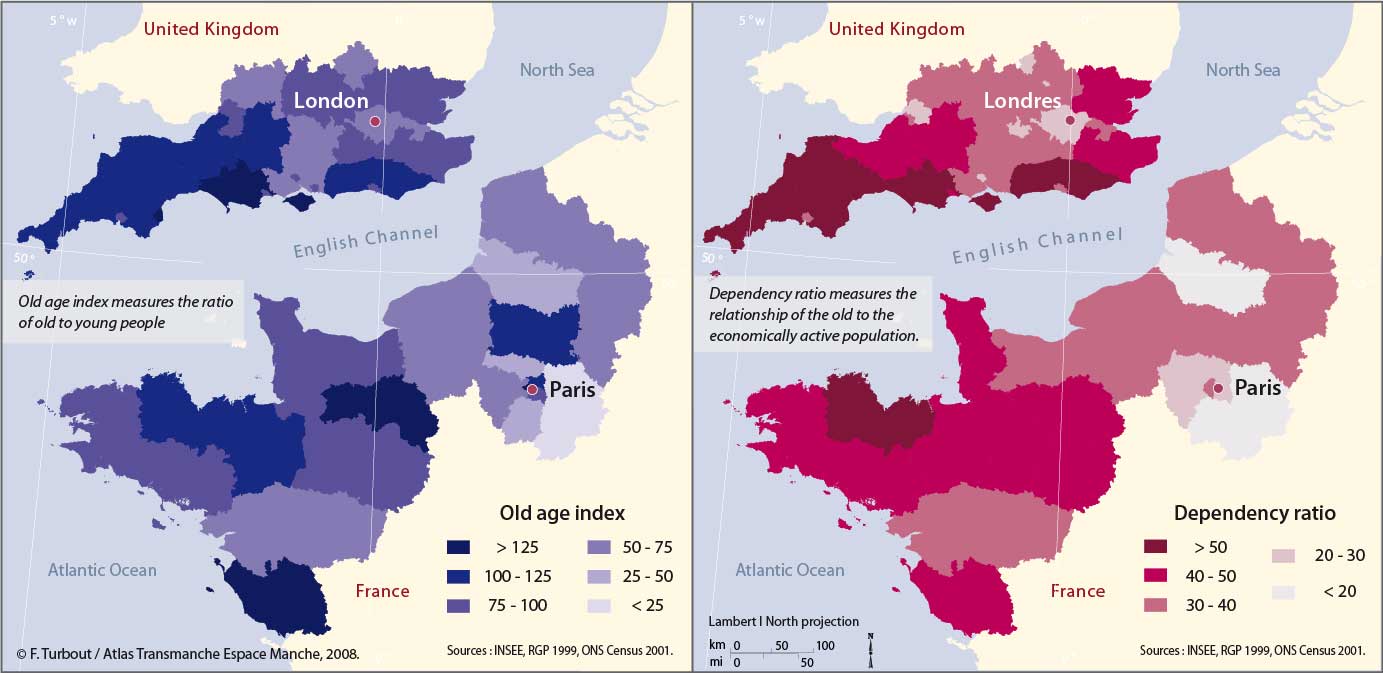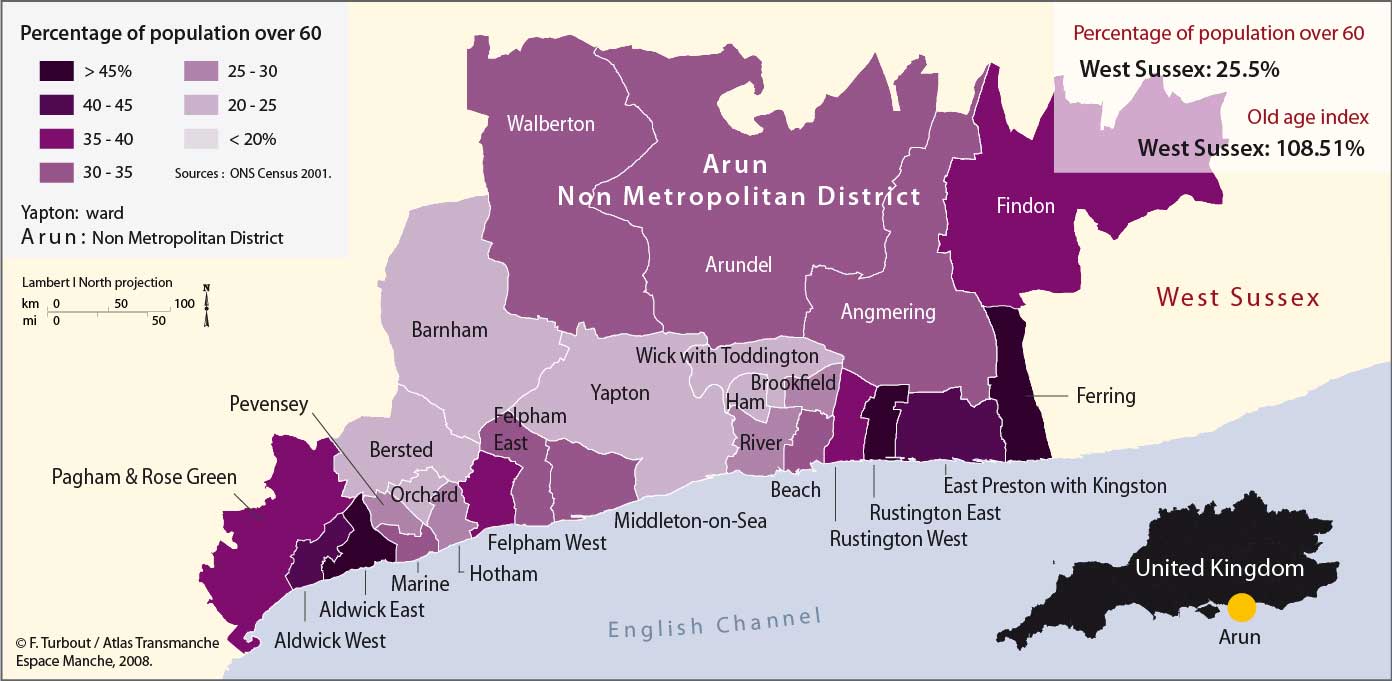

 Ageing
Ageing- Ageing demographic structure (2001)
- Couloir de vieillissement (2011) FR
Demographically, Europe is an ageing continent. In 1950 only 10% of its total population was aged over 65. During the half century that followed, the number of elderly people had doubled, and it is still increasing today. This general trend towards stagnation and zero growth has been viewed by some as the “Second Demographic Transition” (characterised by a fall in fertility rather than mortality as in the first demographic transition). Today, one must also add the continuing impact of increase in life expectancy. The ramifications for both society and economy are far-reaching, as welfare and health-care systems struggle to cope as they accommodate to this demographic change.
Clearly there is significant variation at a national level across the continent, but it is the regional differences brought about by internal migrations that have often exacerbated particular situations. Across the Channel region, southern England was differentially affected at an early stage, whilst Northern France's “fertile crescent” (so-called because of the impact of the postwar baby boom) followed on much later. At the turn of the century, that baby boom generation was turning 60.
At the start of the 1980's, the percentage of under 20's was higher than that of the over 60's age group in most departments and counties of the Channel region. Indeed, only in Devon, East and West Sussex and the Isle of Wight had the over 60's group already overtaken the under 20's. Today, the situation has changed considerably: in all the departments, the index used to measure old age exceeds the 50 mark and frequently attains 90. Ten counties in a band from East Sussex through to Cornwall exceed this threshold, as do the departments of Finistère, Morbihan and Orne... and the trend continues.
This general picture conceals significant variations within the different counties and departments where one finds contrasting situations across the agglomerations, along a continuum ‘major city-suburb,' and that of ‘town-rural-coastal.' Paris and London, attract and retain the young and more actively employed within their wider encircling metropolitan regions. The large, and to a lesser extent medium-sized towns hold the same attraction within each county and region.
Ageing across the Channel region reflects this general shift in population, which started earlier on the English side. An east-west gradient is again evident, with ageing being more marked to the west. Any ageing regional demographic profile has been and continues to be accentuated by migration. To the ageing in situ of a region produced by the departure of the young from rural areas, leaving the older population behind, one must add the impact of retirement migration. Certain regions are attractive by virtue of their overall way of life, their landscape and the pleasure gained from living there. Thousands of people, sometimes originally from the region and who have spent their working life elsewhere, come back to settle; thousands of others have visited the area at one time or another and made the choice to return.
This type of migration started very early along the south coast of England: Brighton, Poole, Lymington and Bognor Regis are all examples of fashionable resorts whose long-established reputations have drawn many generations of retired. The numbers involved along the southern English coast are much higher than found on the northern coasts of France, but nowhere match those of the Côte d'Azur. Nevertheless, the large numbers retiring to the coast of Brittany and Normandy (as well as progressively further eastwards) have risen rapidly in recent decades.
However, this wave of retirement migration is not only directed towards coastal areas, even though they remain the most affected. Rural areas inland have also proved attractive as locations. Overall the trend towards over-concentration, even saturation, in certain areas, inflating prices of land and housing, has brought about inevitable fluctuations in the market and occasional slow-downs, but nevertheless is now not just well-established but growing.
The larger part of these migrations takes place on a national scale, spreading from the large towns and cities which generate an outflow of population towards rural and coastal areas. However, the latter has also penetrated beyond the sea, across the Channel. The flows of migrants from either side greatly increased between 1980 and 2000, but were far from similar. The French crossing to England headed for the towns; London primarily, but also the larger towns in the south, leaving either to take up employment or to study. Some English moved to France for the same reasons, and primarily to Paris, though this did not represent the main motivation. Many of the English contingent had already acquired property in France. Even though the Dordogne region was most favoured, a large proportion also chose Brittany, Normandy and the Loire Valley for their second homes, more recently going to the Somme and Pas-de-Calais regions too. This population mobility is largely explained by the significant difference in property prices alongside the attraction of an appealing way of life. On reaching retirement age many of these second-home owners chose to move more permanently to France, maintaining two homes as do many of their French counterparts.
The regions on either side of the Channel area now find themselves faced with radically different parameters of population change: a long term structural ageing and a tangible growth in population occasioned by inward migration.
Public authorities and private agencies alike are beginning to recognise the importance of these fundamental changes and to respond. A person of 60 to 70 years of age in 2005-2010 is not the same as someone of the same age back in the 1960's. Today the older generation is much more active and involved in numerous sporting, cultural and recreational pursuits. This section of the population often enjoys substantial purchasing power. It is above all this new energy, new wealth, as well as more free time that accompanies those arrivals into their new found communities.The growing importance of the over 80 age group brings with it other problems at different levels, notably that of greater dependency on social care services. In this area too, provision has also been the subject of changing policies and the development of more flexible support structures that prioritise home-based care and more individual attention.
There is little doubt that new information technologies, and the information revolution generally, will be fully used in the
development of different approaches in support of older people's way of life as well as their care, protection and life at home. The years to come will see the continuation of present trends
in the Channel region at the same time as the creation of new organisations within local communities, established in response to an ageing society.
top
















